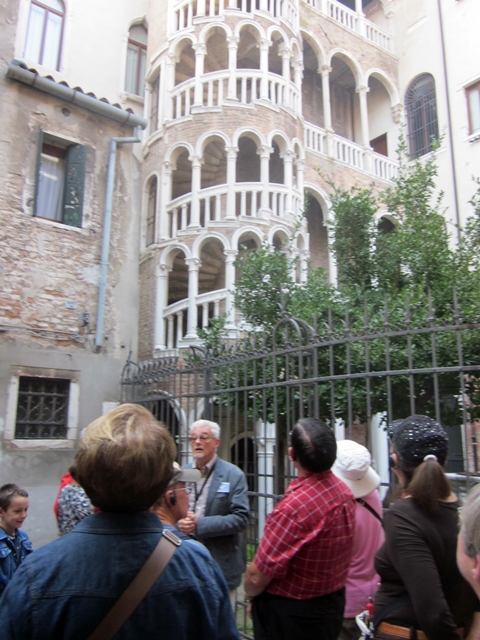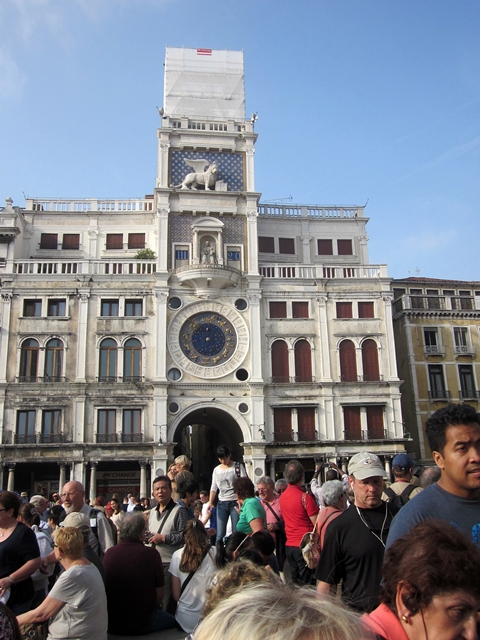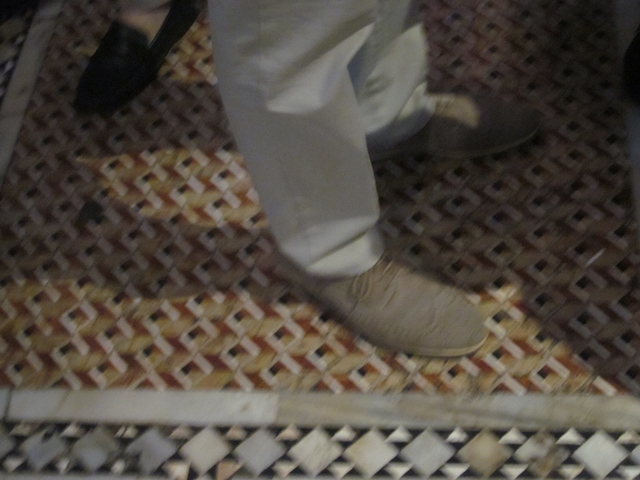Venice in a day
Venice was our last stop in Italy. We were to be there less than a day. (We were scheduled to fly out the next morning.) But I think we saw the most important landmarks.
Before we start our tour of Venice I’d like to point out a little of the city’s history:
The city of Venice is made up of 117 islands that are linked together by water canals, numerous small bridges, as well as 3 large bridges over the Grand Canal. According to tradition, Venice was founded in 421 AD.
Venice history dates back many years when people sought refuge here. These people built upon the lagoon for safety from being attacked. In the lagoon there a collection of small island of rock and mud islets and it was here that these people started driving wood pilings into the mud, sand and, clay. The wood pilings became the initial foundation.
However, there is another question to be answered. Where did the wood come from as Venice did not did have any forest? Most of these piles were made from trunks of alder trees, a wood noted for its water resistance. The alder came from the westernmost part of today’s Slovenia (resulting in the barren land of the Kras region) and in two regions of Croatia. The timber was then transported by water to Venice.
How could the Venetians use vertical wood pilings in the salt water for a foundations system without the wood rotting? The wood is not exposed to oxygen as it is submerged in the water and mud and as a result it does not rot. In fact the wood becomes petrified due to a constant flow of mineral rich water around and through it. As a result the wood becomes a hardened stone-like structure.
Once the all wood pilings are driven side by side into the mud of the lagoon as the initial foundation, they are then cut level and horizontal timber are laid. A stone foundation is then placed on top of the horizontal timbers. From there the building is built using wood framing techniques or brick. Who would ever have thought that the city of Venice with all its canals and gondolas was built on a foundation of wood.
Plans are afoot as well to improve Venice’s treatment of sewage, which for centuries has been dumped directly into the canals. Venetians are now installing septic tanks as buildings and market areas undergo renovation, and authorities hope that within the next two decades, traditional sewer pipes can deliver the city’s waste to mainland water-treatment facilities. Finally, St. Mark’s Square, the city’s lowest point and most frequently flooded area, is slated for a $50 million project to rebuild its drainage system.
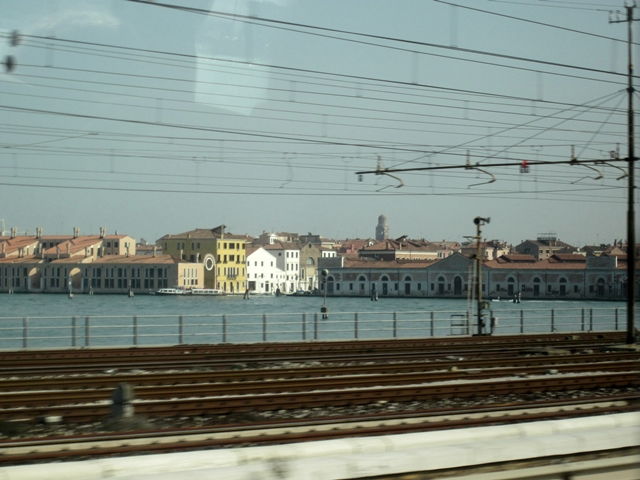 Our tour bus could not enter the city so we had to take a train in.
Our tour bus could not enter the city so we had to take a train in.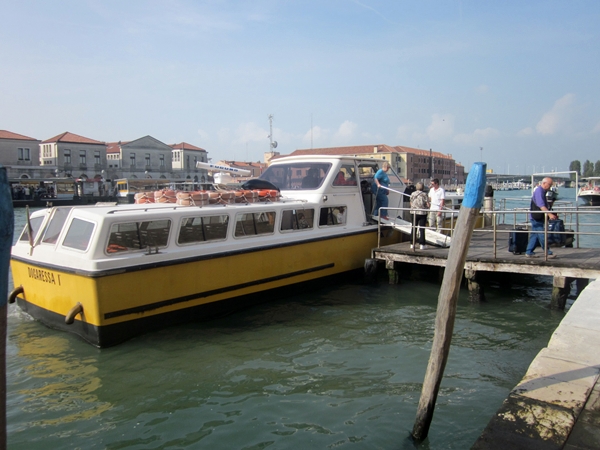
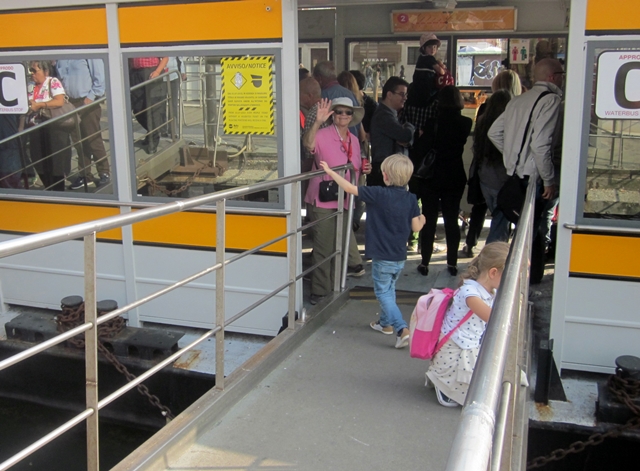 Since there are no automobiles or trucks in Venice, we got from the train to our hotel on a “water” bus. These had regular routes and stops just like a “land” bus.
Since there are no automobiles or trucks in Venice, we got from the train to our hotel on a “water” bus. These had regular routes and stops just like a “land” bus. 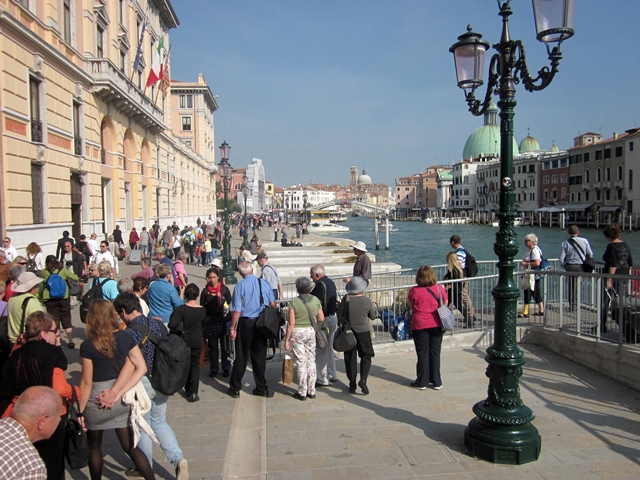
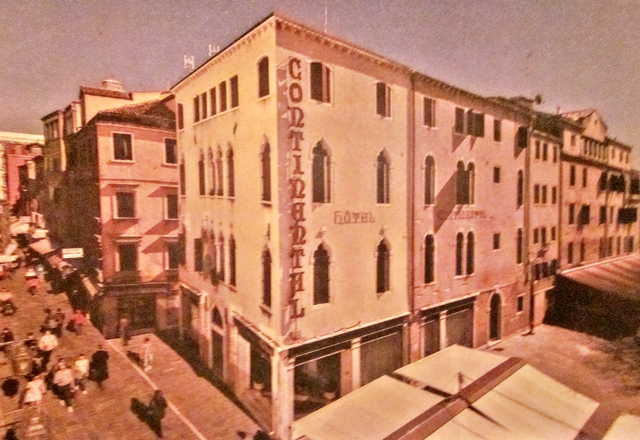 We schlepped our carry-on bags along the Grand Canal (the main thoroughfare of Venice) to our hotel. The hotel looks small, but it’s actually a collection of old building that have been connected internally into one building with halls and rooms of varying sizes and heights. The far right is end of the hotel is on the Grand Canal.
We schlepped our carry-on bags along the Grand Canal (the main thoroughfare of Venice) to our hotel. The hotel looks small, but it’s actually a collection of old building that have been connected internally into one building with halls and rooms of varying sizes and heights. The far right is end of the hotel is on the Grand Canal. After we got settled, we met our Venice City Guide (name misplaced) for a tour of the city.
After we got settled, we met our Venice City Guide (name misplaced) for a tour of the city.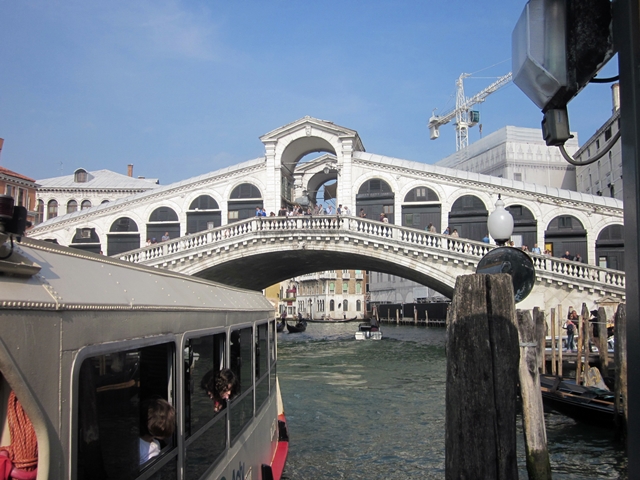 We stopped to look at the Rialto Bridge. It is one of the most exquisite sights in the whole of Venice. The oldest of the four bridges spanning the city’s Grand Canal.
We stopped to look at the Rialto Bridge. It is one of the most exquisite sights in the whole of Venice. The oldest of the four bridges spanning the city’s Grand Canal.
Some of the best architects of the day, including Michelangelo, submitted designs for this project but the eventual winner was Antonio da Ponte, whose idea combined simplicity with striking beauty.
Da Ponte’s design is an architectural marvel, consisting of two sloped ramps leading to a central portico. The ramps are covered and contain a range of different shops, reflecting the commercial aspect of this district.
The current bridge was completed in 1591, taking just three years to finish, and was a replacement for the various wooden bridges that crossed the Grand Canal from the beginning of the 13th century onwards. It was the only way to cross the canal for nearly 300 years until the completion of the Accademia Bridge in 1854.
Our Guide led us up and down narrow alleys that are the streets of Venice.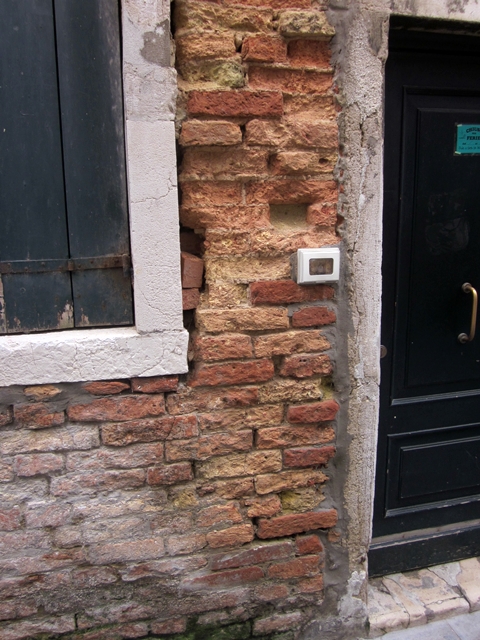
I noticed that a lot of the brick work was disintergrating. It give the impression that Venice is slowly crumbling away.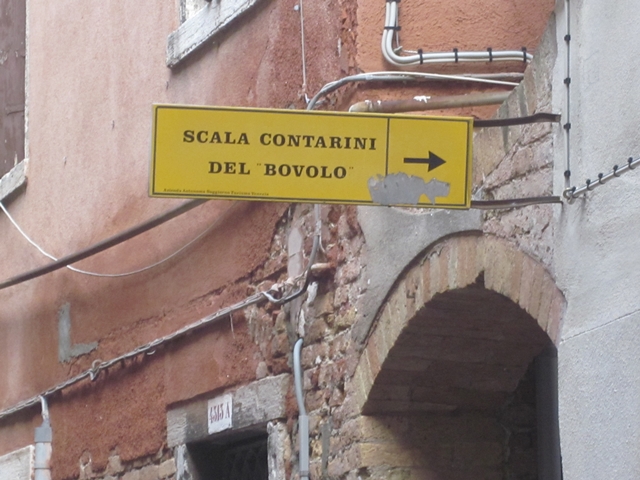
The Palazzo Contarini del Bovolo is a small palace in Venice, best known for the external spiral staircase with a plethora of arches. It is known as the Scala Contarini del Bovolo (of the snail).
The palace is located in a less-traveled side-street (indeed!) near the Campo Manin, near the Rialto Bridge.The stairs lead to an arcade, providing a charming panoramic view over some of the roof-tops of the city. (Which we didn’t get to see.)

 We walked back to the Grand Canal where it was explained to us that most of the Palaces were similar in architecture: A lower level that was a combination of business and warehouse spaces; a middle level that was living quarters; and an upper level for bedrooms and servants.
We walked back to the Grand Canal where it was explained to us that most of the Palaces were similar in architecture: A lower level that was a combination of business and warehouse spaces; a middle level that was living quarters; and an upper level for bedrooms and servants.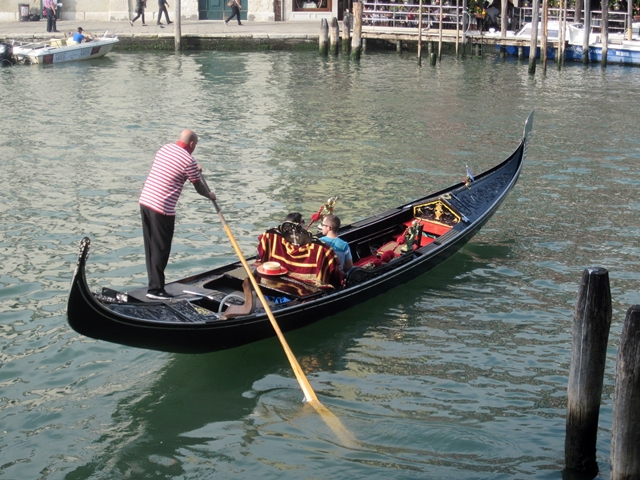 Of course, we saw lots of gondolas. They are the symbol of Venice. We could take a gondola ride for about 80 Euros (not including singing). We passed…
Of course, we saw lots of gondolas. They are the symbol of Venice. We could take a gondola ride for about 80 Euros (not including singing). We passed…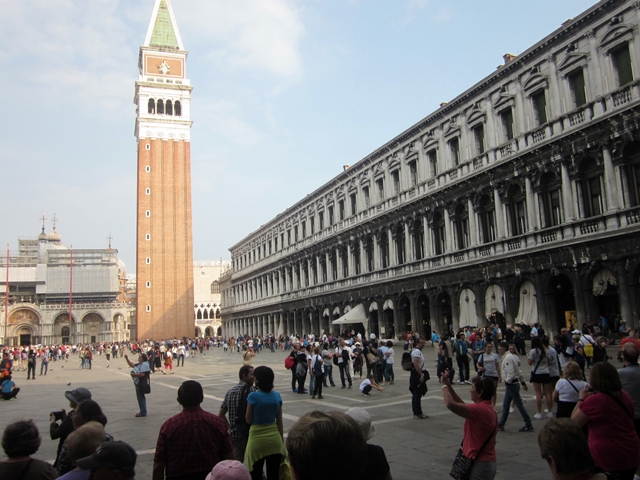 This is St Mark’s Square with the Bell Tower and St Marks Basilica in the far left. The tower is 323 feet tall, and stands alone in a corner of St Mark’s Square, near the front of the basilica. It has a simple form, the bulk of which is a fluted brick square shaft, 39 feet wide on each side and 160 feet tall, above which is a loggia surrounding the belfry, housing five bells. The belfry is topped by a cube, alternate faces of which show the Lion of St. Mark and the female representation of Venice. The tower is capped by a pyramidal spire, at the top of which sits a golden weather vane in the form of the archangel Gabriel. The campanile reached its present form in 1514. The current tower was reconstructed in its present form in 1912 after the collapse of 1902. It costs 8 Euros to climb or take an elevator.
This is St Mark’s Square with the Bell Tower and St Marks Basilica in the far left. The tower is 323 feet tall, and stands alone in a corner of St Mark’s Square, near the front of the basilica. It has a simple form, the bulk of which is a fluted brick square shaft, 39 feet wide on each side and 160 feet tall, above which is a loggia surrounding the belfry, housing five bells. The belfry is topped by a cube, alternate faces of which show the Lion of St. Mark and the female representation of Venice. The tower is capped by a pyramidal spire, at the top of which sits a golden weather vane in the form of the archangel Gabriel. The campanile reached its present form in 1514. The current tower was reconstructed in its present form in 1912 after the collapse of 1902. It costs 8 Euros to climb or take an elevator.
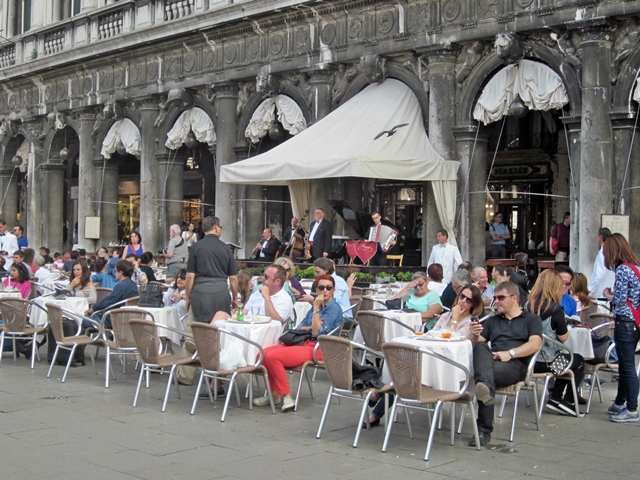 This is the plaza view of “Il Caffè Florian”. It was opened in 1720 It is is Italy’s oldest cafe. While seated in one of the cafe’s frescoed rooms or outside listening to the orchestra in the Piazza, one can enjoy impeccable service and products of the finest quality.
This is the plaza view of “Il Caffè Florian”. It was opened in 1720 It is is Italy’s oldest cafe. While seated in one of the cafe’s frescoed rooms or outside listening to the orchestra in the Piazza, one can enjoy impeccable service and products of the finest quality.
Famous for its rich history as a crossroads of art, culture, politics and entertainment, today the Florian is also known for its elegant trademark products: coffee, teas, chocolates, cookies, porcelains, and design objects.
Note the orchestra under the canopy. This is the place to see or be seen.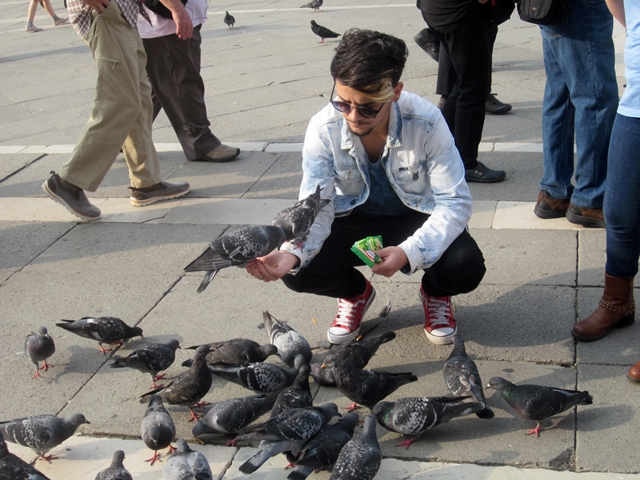
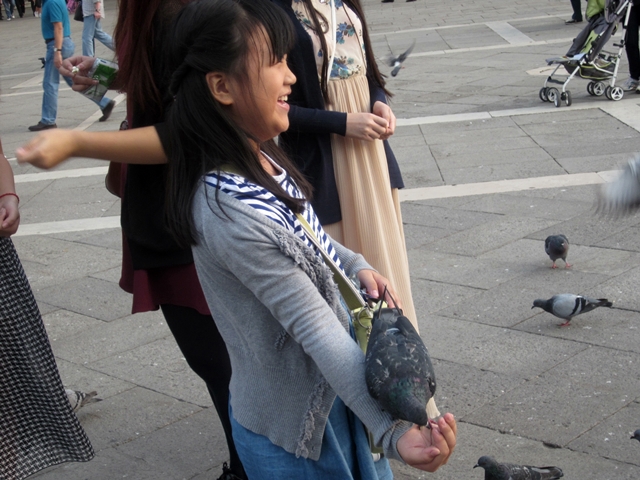 Besides being filled with people and great specimens of architecture, Piazza San Marco is also full of pigeons. Pigeons have long been a problem in the square but only recently did the city pass a law that banned the feeding of these birds. Yeah, tell it to these tourists…
Besides being filled with people and great specimens of architecture, Piazza San Marco is also full of pigeons. Pigeons have long been a problem in the square but only recently did the city pass a law that banned the feeding of these birds. Yeah, tell it to these tourists…
Here is the Clock tower. It is an early renaissance building on the north side of the Piazza. Both the tower and the clock date from the last decade of the 15th century, though the mechanism of the clock has subsequently been much altered. It was placed where the clock would be visible from the waters of the lagoon and give notice to everyone of the wealth and glory of Venice.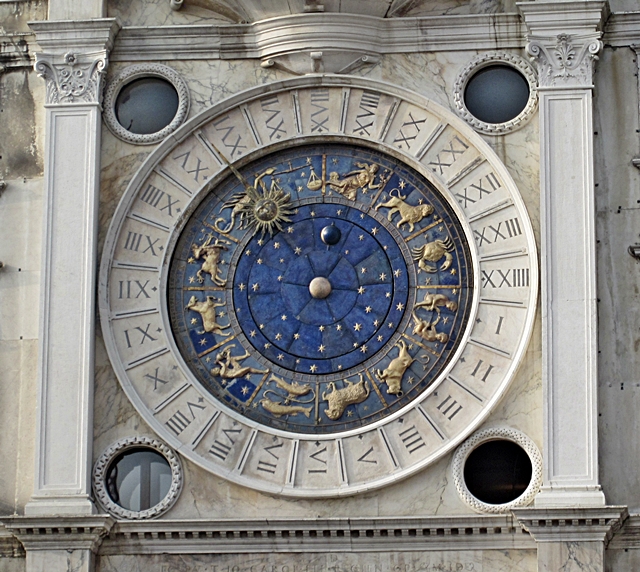
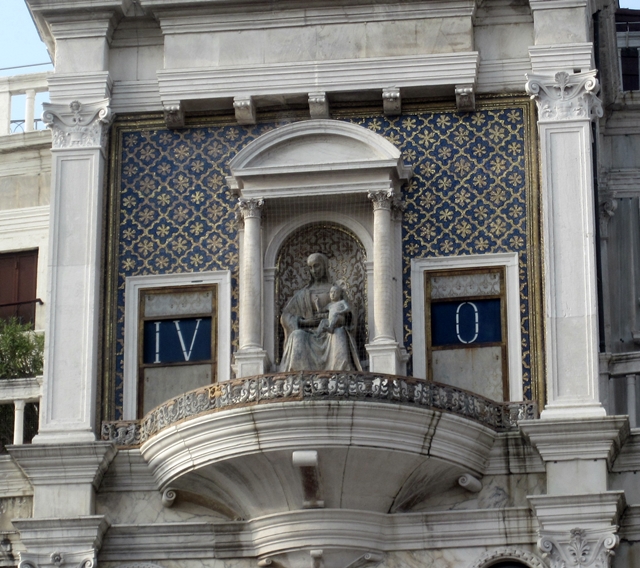
 The three main features of the clock tower are: The 24 hour zodiac clock which is pointing to 4:00 PM (XVI); a “digital” clock currently showing 4-0 (minutes are in increments of 5), and the “Lion of St Mark”.
The three main features of the clock tower are: The 24 hour zodiac clock which is pointing to 4:00 PM (XVI); a “digital” clock currently showing 4-0 (minutes are in increments of 5), and the “Lion of St Mark”.
The Lion of Saint Mark, represents the evangelist St Mark, pictured in the form of a winged lion, It is the symbol of the city of Venice and formerly of the Republic of Venice (we saw one in Verona). It appears also in both merchant and military naval flags of the Italian Republic.
Venetian tradition states that when St. Mark was traveling through Europe, he arrived at a lagoon in Venice, where an angel appeared to him and said “Pax tibi Marce, evangelista meus. Hic requiescet corpus tuum.” (May Peace be with you, Mark, my evangelist. Here your body will rest.) This tradition was used as justification for stealing the remains of St. Mark from his grave in Alexandria, and moving them to Venice, where they were eventually interred in the Basilica of St. Mark.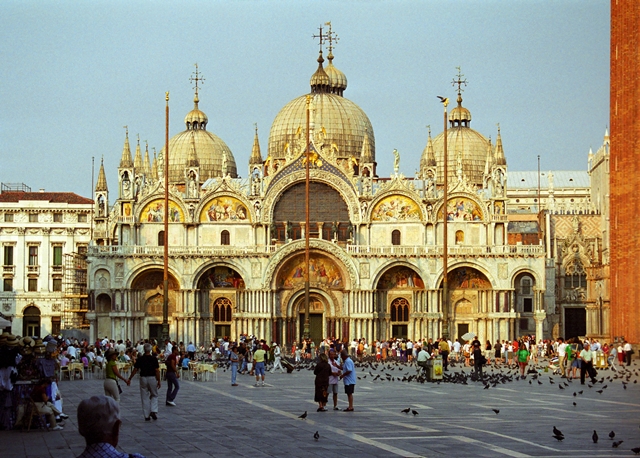 Here is what St Mark’s Basilica should look like. At present it is undergoing renovations and the facade is covered with scaffolding and canvas. The red border on the right is part of the Bell tower.
Here is what St Mark’s Basilica should look like. At present it is undergoing renovations and the facade is covered with scaffolding and canvas. The red border on the right is part of the Bell tower.
From perhaps 1073 the present basilica was being constructed. The basic structure of the building has not been much altered. Its decoration has changed greatly over time, though the overall impression of the interior with a dazzling display of gold mosaics on all ceilings and upper walls remains the same. The succeeding centuries, especially the period after the Venetian-led conquest of Constantinople in the Fourth Crusade of 1204 and the fourteenth century, all contributed to its adornment, with many elements being spoils brought in from ancient or Byzantine buildings, such as mosaics, columns, capitals, or friezes.
 Here is the mosaic over the main entrance. It is made with gold leaf and colored tiles that are covered in glass to protect them from the elements.
Here is the mosaic over the main entrance. It is made with gold leaf and colored tiles that are covered in glass to protect them from the elements.
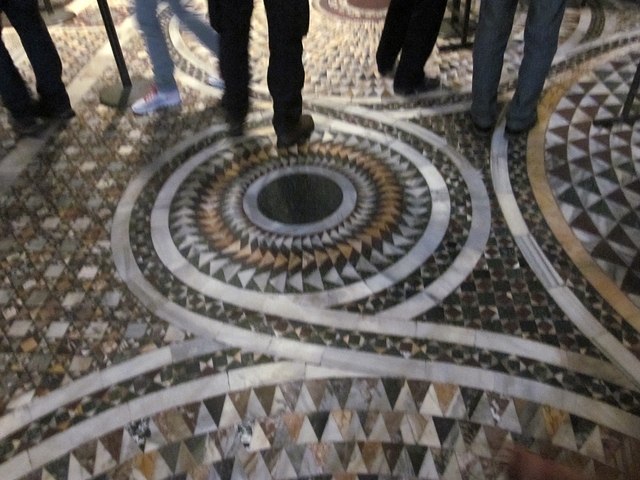 The floors of the Basilica were covered with different patterns of mosaic tiles. Mary Ann said they’d be good quilt designs.
The floors of the Basilica were covered with different patterns of mosaic tiles. Mary Ann said they’d be good quilt designs.
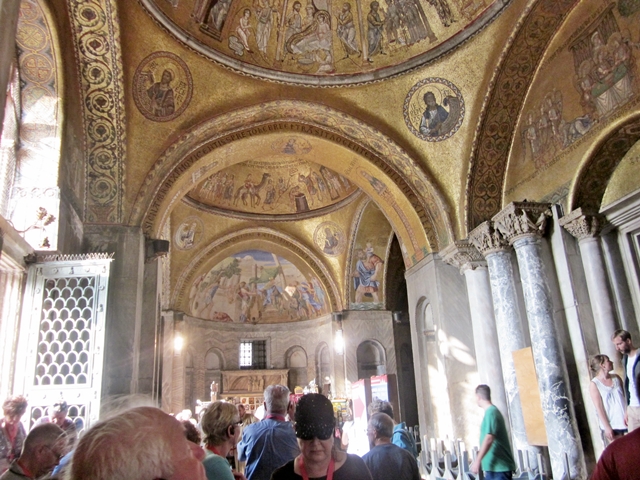 The interiors of the 5 domes were also covered with more mosaics. It’s too damp this close to the water for frescos.
The interiors of the 5 domes were also covered with more mosaics. It’s too damp this close to the water for frescos.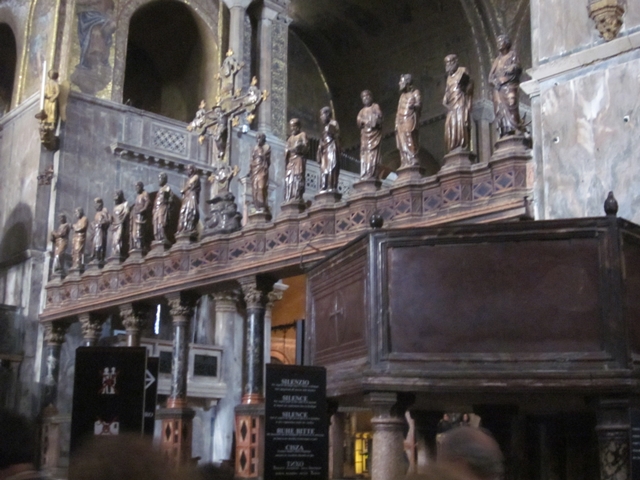 The Apostles and the Virgin Mary stand guard in front of he altar. The floor in the main part of the sanctuary is so warped by settling that the pews no longer can be used. Now it’s all folding chairs.
The Apostles and the Virgin Mary stand guard in front of he altar. The floor in the main part of the sanctuary is so warped by settling that the pews no longer can be used. Now it’s all folding chairs.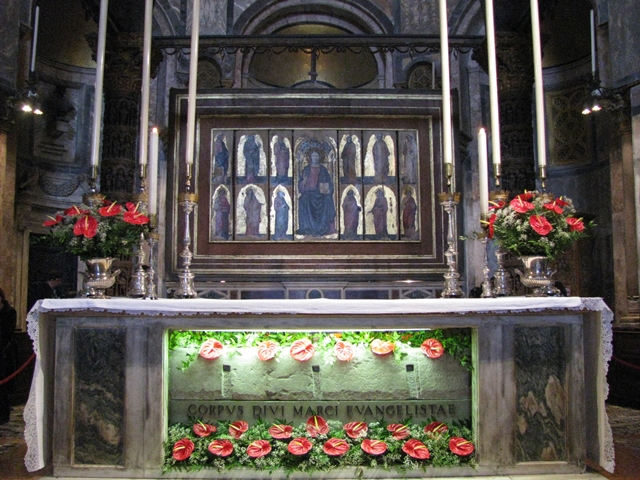 Here is the St Mark’s Altar. Supposedly St Mark’s relics are in there.
Here is the St Mark’s Altar. Supposedly St Mark’s relics are in there.
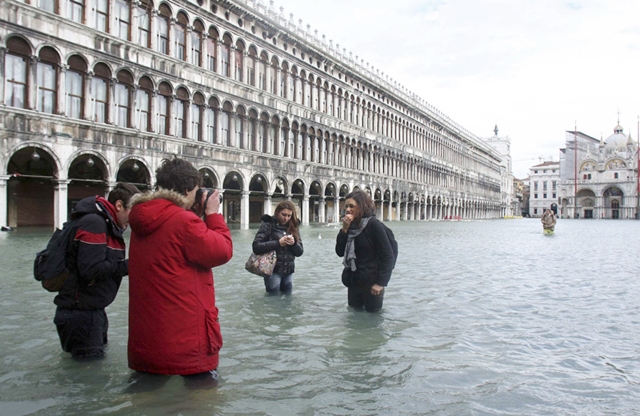 Here is St Mark’s Square at an unusually high tide. The “acqua alta” (high water) in Venice reached a depth of 5 feet, 1 inch on December 3, 2008 – the deepest flood in 22 years, and the fourth highest flood level in recent history, claimed Venice’s Tide Center. The water began to subside , while residents and tourists made their way through the city, hip-waders or not. Although this flood was severe enough for the mayor to ask tourists to temporarily stay home, Venetian floods are fairly routine, several occurring every year, and residents usually take it all in stride. That’s St Mark’s back there. Water filled the sanctuary.
Here is St Mark’s Square at an unusually high tide. The “acqua alta” (high water) in Venice reached a depth of 5 feet, 1 inch on December 3, 2008 – the deepest flood in 22 years, and the fourth highest flood level in recent history, claimed Venice’s Tide Center. The water began to subside , while residents and tourists made their way through the city, hip-waders or not. Although this flood was severe enough for the mayor to ask tourists to temporarily stay home, Venetian floods are fairly routine, several occurring every year, and residents usually take it all in stride. That’s St Mark’s back there. Water filled the sanctuary.
Mary Ann and I hung around a while watching the people and then took a water bus back to our hotel. We bought a bottle of beer and finished off our cheese and crackers and got ready for our final dinner with the group. he dinner was in a quaint restaurant and the food was excellent – fish and wine. (Sorry, no pic.)
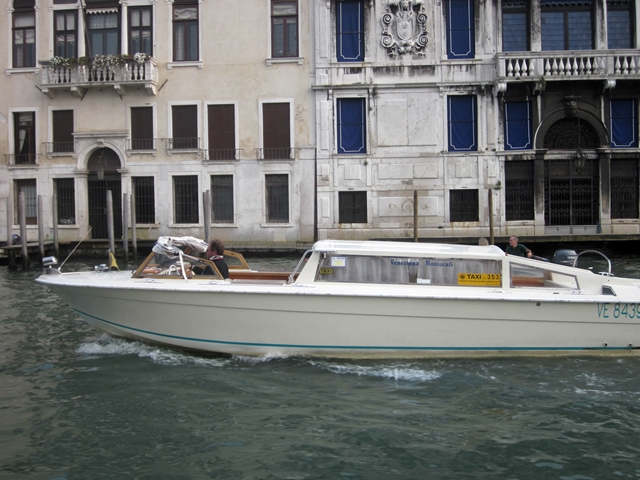 I did get a picture of an airport water “taxi” during the day. It would be like the one we took at 5AM the next morning. It was a hair raising ride across the lagoon, leaping along at maximum speed in the pitch dark. Mary Ann was hanging on for dear life. I have a pic, but I won’t show it.
I did get a picture of an airport water “taxi” during the day. It would be like the one we took at 5AM the next morning. It was a hair raising ride across the lagoon, leaping along at maximum speed in the pitch dark. Mary Ann was hanging on for dear life. I have a pic, but I won’t show it.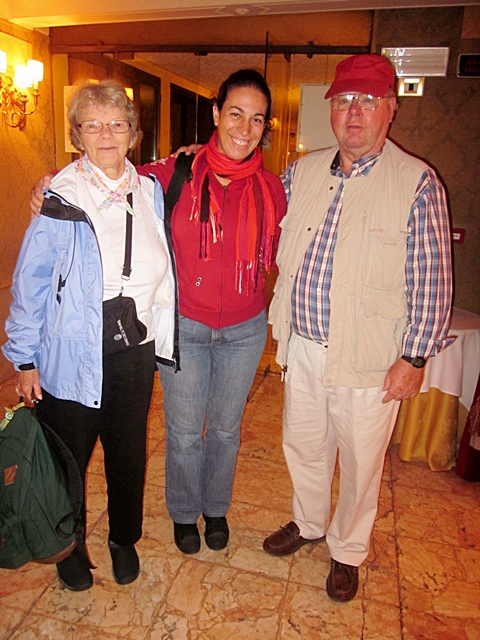 This is our farewell picture of us with Eva Troncon our able and affable GCT Program Director. She saw us off (with a smile) at 5AM.
This is our farewell picture of us with Eva Troncon our able and affable GCT Program Director. She saw us off (with a smile) at 5AM.
We got to the Venice airport alive, waited several hours for our flight to Paris and waited several more hours for our 9 hour flight to Boston. We spent the night at our daughters place and got the DownEaster train back to Wells, Maine. We spent the night at a motel there. We then packed up our travel trailer and left for a 10 day trip to our Florida home. It was a long trip home, but, with all we saw and did, it was more than worthwhile. Thanks GCT!
Th’ Th’ Th’ That’s all folks!
PS If you have any corrections, comments, compliments, and/or criticisms, please email me at: prstevens13@gmail.com.


